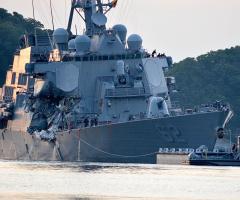 There is a tragic irony in the collision of the guided-missile cruiser USS Fitzgerald, which resulted in the death of seven of its crew. The Fitzgerald is built around one of the most advanced anti-missile radar systems in the world and yet when it turned into the path of the container ship ACX Crystal on June 17, 2017, the officers on the bridge of the cruiser didn’t know the containership was there until it was too late. The ship designed to intercept incoming ballistic missiles traveling at hundreds of miles an hour failed to spot a 730-foot long container ship traveling at less than 20 knots.
There is a tragic irony in the collision of the guided-missile cruiser USS Fitzgerald, which resulted in the death of seven of its crew. The Fitzgerald is built around one of the most advanced anti-missile radar systems in the world and yet when it turned into the path of the container ship ACX Crystal on June 17, 2017, the officers on the bridge of the cruiser didn’t know the containership was there until it was too late. The ship designed to intercept incoming ballistic missiles traveling at hundreds of miles an hour failed to spot a 730-foot long container ship traveling at less than 20 knots.
What happened? Was it a problem with equipment and technology or with personnel?
Shortly after the collision, the Navy assigned Rear Adm. Brian Fort to find the answers to these questions. Rather than release the report, the Navy kept it secret, notionally to allow the Navy to prepare for potential lawsuits related to the collision. This month, the Navy Times acquired a copy of the report which revealed that conditions on board the ship were far worse than previously indicated.
The Navy Times reports that Fort’s team of investigators described a bridge team that was overworked and exhausted, plagued by low morale, facing a relentless tempo of operations decreed by admirals far above them, distrustful of their superiors and, fatally, each other. And Navy officials knew all of that at least a year before the tragedy.
The Fort report found that there was “confusion, indecision, and ultimately panic,” immediately prior to the collision. “Watchstanders were unaware of this approaching and dynamic change in the surface traffic pattern and sailed headlong into this crossing traffic at 20 knots,” Fort wrote.
Fort found a Voyage Management System that generated more “trouble calls” than any other key piece of electronic navigational equipment. Designed to help watchstanders navigate without paper charts, the VMS station in the skipper’s quarters was broken so sailors cannibalized it for parts to help keep the rickety system working.
The problems extended well beyond the bridge. The Navy Times also notes that when Fort walked into the trash-strewn combat information center (CIC) in the wake of the disaster, he was hit with the acrid smell of urine. He saw kettlebells on the deck and bottles filled with pee.
Fort found the CIC had “zero communication” with the bridge team before the Crystal loomed seemingly out of nowhere to rip into the Fitzgerald’s starboard hull.
It has been widely reported that the Fitzgerald’s AIS was turned off prior to the collision. The Fort report suggests that the system was chronically malfunctioning, so even if it had been turned on it may not have helped.
At least one of the Fitzgerald’s radar systems was acting up the night of the collision and no one knew how to fix it. Fort also suggested that in cases where equipment was working, some inexperienced crew did not know how to operate it.
Part of the problems may have begun at the top. The commanding officer (CO) spent very little time on the bridge after dark. The report indicates that out of 78 underway days from February to May of that year, the CO was on the bridge just four times between the dark hours of 10 p.m. to 6 a.m. The CO was was absent during the passage through the congested waterway where the collision took place. Standing orders to notify the CO or XO of dangerous situations were routinely ignored.
Thanks to David Rye and Phil Leon for contributing to this post.

A fair summing up from the American perspective, thank you Rick.
Sigh, such an interesting time we live in.
Whatever happened to the Mk1 eyeball? It was cheap, plentiful and connected to a supercomputer. It saved many millions in its time but I hear was pensioned off as unreliable.
Not sure if the eyeball became obsolete because of the lack of windows in modern warships or the other way around.